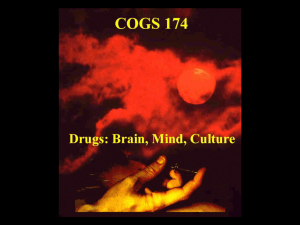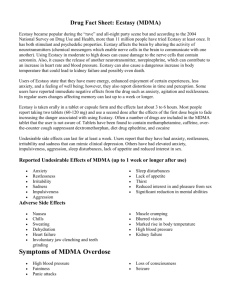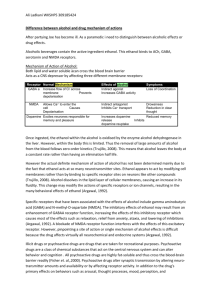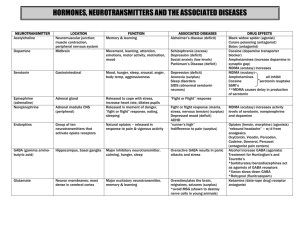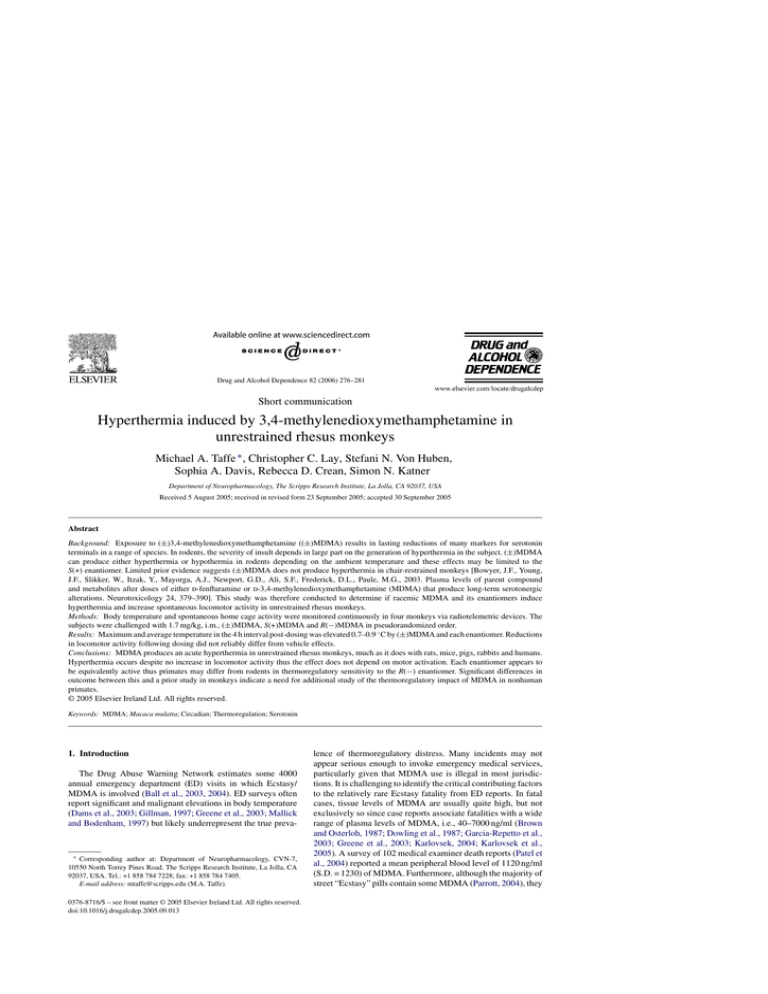
Drug and Alcohol Dependence 82 (2006) 276–281
Short communication
Hyperthermia induced by 3,4-methylenedioxymethamphetamine in
unrestrained rhesus monkeys
Michael A. Taffe ∗ , Christopher C. Lay, Stefani N. Von Huben,
Sophia A. Davis, Rebecca D. Crean, Simon N. Katner
Department of Neuropharmacology, The Scripps Research Institute, La Jolla, CA 92037, USA
Received 5 August 2005; received in revised form 23 September 2005; accepted 30 September 2005
Abstract
Background: Exposure to (±)3,4-methylenedioxymethamphetamine ((±)MDMA) results in lasting reductions of many markers for serotonin
terminals in a range of species. In rodents, the severity of insult depends in large part on the generation of hyperthermia in the subject. (±)MDMA
can produce either hyperthermia or hypothermia in rodents depending on the ambient temperature and these effects may be limited to the
S(+) enantiomer. Limited prior evidence suggests (±)MDMA does not produce hyperthermia in chair-restrained monkeys [Bowyer, J.F., Young,
J.F., Slikker, W., Itzak, Y., Mayorga, A.J., Newport, G.D., Ali, S.F., Frederick, D.L., Paule, M.G., 2003. Plasma levels of parent compound
and metabolites after doses of either d-fenfluramine or d-3,4-methylenedioxymethamphetamine (MDMA) that produce long-term serotonergic
alterations. Neurotoxicology 24, 379–390]. This study was therefore conducted to determine if racemic MDMA and its enantiomers induce
hyperthermia and increase spontaneous locomotor activity in unrestrained rhesus monkeys.
Methods: Body temperature and spontaneous home cage activity were monitored continuously in four monkeys via radiotelemetric devices. The
subjects were challenged with 1.7 mg/kg, i.m., (±)MDMA, S(+)MDMA and R(−)MDMA in pseudorandomized order.
Results: Maximum and average temperature in the 4 h interval post-dosing was elevated 0.7–0.9 ◦ C by (±)MDMA and each enantiomer. Reductions
in locomotor activity following dosing did not reliably differ from vehicle effects.
Conclusions: MDMA produces an acute hyperthermia in unrestrained rhesus monkeys, much as it does with rats, mice, pigs, rabbits and humans.
Hyperthermia occurs despite no increase in locomotor activity thus the effect does not depend on motor activation. Each enantiomer appears to
be equivalently active thus primates may differ from rodents in thermoregulatory sensitivity to the R(−) enantiomer. Significant differences in
outcome between this and a prior study in monkeys indicate a need for additional study of the thermoregulatory impact of MDMA in nonhuman
primates.
© 2005 Elsevier Ireland Ltd. All rights reserved.
Keywords: MDMA; Macaca mulatta; Circadian; Thermoregulation; Serotonin
1. Introduction
The Drug Abuse Warning Network estimates some 4000
annual emergency department (ED) visits in which Ecstasy/
MDMA is involved (Ball et al., 2003, 2004). ED surveys often
report significant and malignant elevations in body temperature
(Dams et al., 2003; Gillman, 1997; Greene et al., 2003; Mallick
and Bodenham, 1997) but likely underrepresent the true preva-
∗ Corresponding author at: Department of Neuropharmacology, CVN-7,
10550 North Torrey Pines Road, The Scripps Research Institute, La Jolla, CA
92037, USA. Tel.: +1 858 784 7228; fax: +1 858 784 7405.
E-mail address: mtaffe@scripps.edu (M.A. Taffe).
0376-8716/$ – see front matter © 2005 Elsevier Ireland Ltd. All rights reserved.
doi:10.1016/j.drugalcdep.2005.09.013
lence of thermoregulatory distress. Many incidents may not
appear serious enough to invoke emergency medical services,
particularly given that MDMA use is illegal in most jurisdictions. It is challenging to identify the critical contributing factors
to the relatively rare Ecstasy fatality from ED reports. In fatal
cases, tissue levels of MDMA are usually quite high, but not
exclusively so since case reports associate fatalities with a wide
range of plasma levels of MDMA, i.e., 40–7000 ng/ml (Brown
and Osterloh, 1987; Dowling et al., 1987; Garcia-Repetto et al.,
2003; Greene et al., 2003; Karlovsek, 2004; Karlovsek et al.,
2005). A survey of 102 medical examiner death reports (Patel et
al., 2004) reported a mean peripheral blood level of 1120 ng/ml
(S.D. = 1230) of MDMA. Furthermore, although the majority of
street “Ecstasy” pills contain some MDMA (Parrott, 2004), they
M.A. Taffe et al. / Drug and Alcohol Dependence 82 (2006) 276–281
are often contaminated with other psychoactive compounds with
thermomodulatory properties (Baggott et al., 2000; Cheng et al.,
2003; Palhol et al., 2002), making it difficult to determine the
specific contribution of MDMA to thermoregulation. Thus, animal models are required to determine the circumstances under
which MDMA can disrupt thermoregulation to further understanding of how such disruption may result in ED visits (and
potential fatality) for the recreational user.
MDMA intake results in an acute elevation of body
temperature in human laboratory studies following doses
(1.5–2.0 mg/kg, p.o.) described as within the range of common
recreational doses (Freedman et al., 2005; Liechti et al., 2000).
MDMA also produces an acute hyperthermia in rats (Brown
and Kiyatkin, 2004; Dafters, 1994; Malberg and Seiden, 1998),
mice (Carvalho et al., 2002; Fantegrossi et al., 2003), guinea
pigs (Saadat et al., 2004), pigs (Fiege et al., 2003; Rosa-Neto
et al., 2004) and rabbits (Pedersen and Blessing, 2001). Body
temperature data have not generally been included in monkey
studies of lasting serotonergic alterations (Insel et al., 1989;
Ricaurte et al., 1988; Taffe et al., 2002a; Taffe et al., 2001). It
is surprising that MDMA apparently reduced body temperature
in chair-restrained rhesus monkeys (Bowyer et al., 2003) and
therefore the present study was undertaken to test the hypothesis that MDMA elevates temperature in unrestrained rhesus
monkeys. A second goal was to determine if MDMA stimulates
locomotor activity in monkeys as it does in rodents (Dafters,
1994; Fantegrossi et al., 2003; Gold and Koob, 1988). Increases
in locomotor activity would complicate the comparison with the
human laboratory studies in which volunteers were not engaging
in significant levels of activity (Freedman et al., 2005; Liechti
et al., 2000).
The enantiomers of MDMA may differ in effect with the S
or (+) enantiomer reported to be more potent in terms of human
subjective response (Shulgin and Shulgin, 2000) and in producing stereotyped behaviors in rats (Hiramatsu et al., 1989). The
S(+)-MDMA enantiomer produces hyperthermia with equivalent efficacy as the racemate in mice, while R(−)MDMA appears
ineffective in elevating temperature (Fantegrossi et al., 2003).
Thus the final goal was to test the hypothesis that racemic
and S(+)-MDMA would stimulate hyperthermia in monkeys
whereas R(−)-MDMA would not.
2. Methods
2.1. Animals
Four male rhesus monkeys (Macaca mulatta; Chinese origin) were employed in this study. Animals were 6–7 years of
age, weighed 8.5–12.5 kg at the start of the study and exhibited
body condition scores (Clingerman and Summers, 2005) of 2.5
(N = 2) or 3.5 (N = 2) out of 5 at the nearest quarterly exam. Daily
chow (Lab Diet 5038, PMI Nutrition International; 3.22 kcal of
metabolizable energy (ME) per gram) allocations were determined by a power function (Taffe, 2004a,b) fit to data provided
in a National Research Council recommendation (NRC/NAS,
2003) and modified individually by the veterinary weight management plan. Daily chow ranged from 140 to 224 g per day for
277
the animals in this study. Animals were individually housed in
a controlled temperature environment (23.5 ◦ C) and fed in the
home cage. The animals’ normal diet was supplemented with
fruit or vegetables 7 days per week and water was available ad
libitum in the home cage at all times. The United States National
Institutes of Health guidelines for laboratory animal care (Clark
et al., 1996) were followed and all protocols were approved by
the Institutional Animal Care and Use Committee of The Scripps
Research Institute.
2.2. Apparatus
Radio telemetric transmitters (TA10TA-D70; Transoma/Data
Sciences International; “DSI”) were implanted subcutaneously
in the flank by, or under supervision of, the TSRI veterinary
staff using sterile techniques. Animals were allowed to recover
for 6 weeks prior to initiating the drug studies. Temperature
and gross locomotor activity recordings were recorded every
10 min. The raw data were collected as a single temperature
value every 10 min and a per-minute average of activity over each
10 min interval. An activity “count” requires a movement across
approximately half of the cage in any direction in this system.
Ambient room temperature (TA ) was also recorded every 10 min
by the system.
2.3. Drug challenge studies
(±)3,4-Methylenedioxymethamphetamine HCl, S(+)3,4methylenedioxymethamphetamine
HCl
and
R(−)3,4methylenedioxymethamphetamine HCl were administered
intramuscularly with a constant dose of 1.7 mg/kg and an
injection volume of 0.1 ml/kg. Drugs were provided by the
National Institute on Drug Abuse. Challenges were administered at 1030 with active doses separated by 1–2 weeks in a
pseudorandomized order. Vehicle challenges were performed
the day prior to active challenge. Ambient temperature averaged
23.5 ◦ C with a daily range of 23–24 ◦ C throughout the study.
The room temperature range in the 4 h interval post-dosing was
23.25–23.75 ◦ C.
Animals were monitored directly by the investigators for a
minimum of 2 h post-challenge via remote video feed. Animals
were housed normally with four monkeys directly across from
them and six additional animals within sight to their left. No
personnel entered the room for 2 h post-injection on vehicle and
active days in variation from the usual M–F routine in which staff
move monkeys in and out of the room for behavioral testing
purposes e.g., (Taffe et al., 2002b, 2004; Weed et al., 1999)
throughout the day.
2.4. Data analysis
Temperature and activity data were averaged over 30 min
bins (i.e., average of three sequential samples). Two way randomized block analysis of variance (ANOVA) was employed to
evaluate acute treatment related effects starting 30 min prior to
injection and continuing a total of 480 min post-injection. This
interval was selected because the lights were turned off for the
278
M.A. Taffe et al. / Drug and Alcohol Dependence 82 (2006) 276–281
maximum activity were derived from the summed activity in
each 10 min interval. For all ANOVAs, significant main effects
were followed up with Fisher’s LSD post hoc test. All statistical analyses were conducted using GB-STAT v7.0 for Windows
(Dynamic Microsystems, Inc., Silver Spring, MD) and the criterion for significance in all tests was p < 0.05.
3. Results
Fig. 1. The mean (N = 4, bars indicate S.E.M.) subcutaneous temperature
and activity values following (A) racemic MDMA, (B) S(+)MDMA and (C)
R(−)MDMA, as well as the respective vehicle challenges, are presented. Temperature values are an average of three sequential 10 min interval samples and
activity data represent the average of summed activity counts across three
sequential 10 min intervals. Injections were made at 1030 for all conditions,
thus the data represent the interval from midnight prior to injection to 1030 the
following day. Shaded regions indicate the night period during which the room
lights are off and arrows indicate the time of injection. A significant increase
from both the 30 min timepoint preceding injection and the corresponding vehicle timepoint is indicated by *. Additional differences of significance are detailed
in Section 3.
evening at the conclusion of this interval. The circadian temperature pattern is sensitive to this, as can be observed in Fig. 1. Thus
the two within subjects factors for ANOVA were time relative
to injection (−30 to 450) and drug treatment condition (vehicle, MDMA) for (±)MDMA, S(+)MDMA and R(−)MDMA.
In addition, the average and maximum (of all 10 min samples)
temperature observed in the interval 4 h post-injection following all three compounds (and related vehicle challenges) was
analyzed in a two way randomized block ANOVA. Average and
The temperature and activity measures exhibited a diurnal
circadian pattern in which activity and temperature increased
when the lights were turned on and decreased noticeably once
lights were turned off (Fig. 1). Mean temperature varied about
2 ◦ C across the day, consistent with a similar daily temperature
pattern for intraperitoneal temperature in Japanese macaques or
subcutaneous temperature in cynomolgous and rhesus macaques
(Almirall et al., 2001; Horn et al., 1998; Takasu et al., 2002).
Temperature dropped significantly across the 4 h analysis period,
as confirmed by main effects of time post-injection for each
of the (±)MDMA [F16,48 = 14.93; p < 0.0001], S(+)MDMA
[F16,48 = 10.16; p < 0.0001] and R(−)MDMA [F16,48 = 10.76;
p < 0.0001] studies.
The administration of (±)MDMA, S(+)MDMA or
R(−)MDMA resulted in a significant elevation of temperature as is shown in Fig. 1. Statistically reliable main effects of
drug treatment condition were confirmed for the (±)MDMA
[F1,3 = 19.88; p < 0.05] and R(−)MDMA [F1,3 = 8.4; p < 0.05]
studies but not the S(+)MDMA [F1,3 = 4.75; p = 0.11] study.
Reliable time × drug condition interactions were also confirmed
in the (±)MDMA [F16,48 = 4.03; p < 0.0001], S(+)MDMA
[F16,48 = 10.91; p < 0.0001] and R(−)MDMA [F16,48 = 2.43;
p < 0.01] studies.
The post hoc analyses confirmed that temperature was significantly increased relative to the 30 min interval prior to injection
30–180 min after (±)MDMA, 0–210 min after S(+)MDMA and
30–150 min after R(−)MDMA. No differences were confirmed
for these intervals following the respective vehicle conditions.
Consistent with the main effect of time post-injection for all
studies, multiple timepoints from ∼300–450 min post-injection
were significantly lower than pretreatment in all (drug or vehicle)
conditions consistent with a circadian cooling that is typically
observed at that time of day.
Locomotor activity was significantly reduced in the interval
post-injection for the (±)MDMA [F16,48 = 4.77; p < 0.0001],
S(+)MDMA [F16,48 = 2.63; p < 0.01] and R(−)MDMA
[F16,48 = 2.94; p < 0.01] studies however no significant differences attributable to drug treatment condition, nor the
interaction of factors were confirmed in any of the analyses.
The average temperature increase observed after (±)MDMA
did not differ significantly from that observed after either enantiomer in the 4 h following injection (Table 1). The ANOVA confirmed a significant effect of drug challenge over vehicle (main
effect of treatment condition [F1,3 = 23.59; p < 0.05] and the post
hoc test confirmed that average temperature was higher than
the respective vehicle challenge day for each test compound.
No differences were observed between active treatment conditions, nor between the three vehicle conditions. The maximum
M.A. Taffe et al. / Drug and Alcohol Dependence 82 (2006) 276–281
279
Table 1
Average and maximum temperature in 4 h post-injection
Temperature
Average (vehicle)
Average (MDMA)
Maximum (vehicle)
Maximum (MDMA)
*
§
Activity
(±)-MDMA
(+)-MDMA
(−)-MDMA
36.9 (±0.21)
37.8 (±0.07)*
37.2 (±0.17)
38.3 (±0.28)*
36.8 (±0.38)
37.6 (±0.15)*
37.1 (±0.42)
37.9 (±0.10)*,§
37.0 (±0.13)
37.7 (±0.12)*
37.4 (±0.10)
38.1 (±0.13)*
(±)-MDMA
115 (±29.6)
73 (±28.1)
393 (±69.7)
307 (±96.4)
(+)-MDMA
119 (±39.0)
62 (±9.8)
410 (±55.9)
278 (±44.3)
(−)-MDMA
104 (±21.2)
83 (±20.5)
402 (±72.3)
354 (±75.9)
A significant difference from the respective vehicle condition.
A significant difference from the (±)MDMA active drug condition.
temperature following drug challenge was also significantly elevated relative to vehicle [F1,3 = 10.29; p < 0.05] and post hoc
evaluation of this effect confirmed a significant increase for
racemic MDMA and each enantiomer over the respective vehicle conditions. In addition, the maximum temperature observed
after (±)MDMA was significantly higher than that observed
after S(+)MDMA. Although both average and maximum 10 min
activity counts (Table 1) were lower relative to vehicle in the 4 h
interval post-MDMA, these effects were not statistically reliable, nor were any differences observed between the enantiomers
and racemic MDMA.
4. Discussion
This study demonstrates that rhesus monkeys develop elevated body temperature following an intramuscular injection of
a moderate dose (1.7 mg/kg) of MDMA under normal (23.5 ◦ C)
ambient temperature conditions. The finding is consistent with
prior reports of MDMA-associated temperature increases in
most species, including humans. Effects of (±)MDMA lasted
about 4 h after injection and resulted in a peak subcutaneous temperature 0.9 ◦ C higher than the maximum temperature observed
after vehicle injection. The average temperatures in the 4 h interval after injection also differed by about 0.9 ◦ C from the vehicle
condition. These results suggest that a prior finding of decreased
colonic temperature in chaired monkeys (Bowyer et al., 2003)
was possibly a consequence of the experimental preparation.
Differences between the Bowyer et al. (2003) results and
the present data are unlikely to be due to ambient temperature
(TA ). The Bowyer et al. studies were conducted under TA of
20.8–21.7 ◦ C (J. Bowyer, M. Paule, personal communication)
which is close to the present 23.5 ◦ C and in both cases TA was
below the wide thermoneutral range (24.7–30.6 ◦ C) estimated
for rhesus monkeys (Johnson and Elizondo, 1979). Thus the
position of the TA relative to thermoneutral conditions cannot
explain the discrepancy. In any case, primates likely differ considerably from rodents in thermoregulatory tolerance to MDMA
since a recent study of humans exposed to 2 mg/kg (±)MDMA
orally showed that core temperature is increased under both 18
and 30 ◦ C TA conditions (Freedman et al., 2005). This is unlike
rodents that become hypothermic following MDMA under sufficiently low TA conditions (Malberg and Seiden, 1998).
Circadian factors are unlikely to explain the differences with
the Bowyer et al. (2003) results either. Although body temperature declines in the late afternoon (e.g., Fig. 1) the injections from
which the temperature data derives in the Bowyer study were
conducted 0800–0900 (J. Bowyer, M. Paule, personal communication) thus normal circadian effects would be to increase or
maintain stable temperatures. One possible explanation is that
the temperatures of the Bowyer animals were artificially elevated during the single pre-MDMA baseline observation due to
the stress of the chairing procedure; however there are plausible alternative hypotheses. The present study used subcutaneous
placement of the temperature probes that would theoretically
make the measure more sensitive to hemodynamic effects of
MDMA. However MDMA produces vasoconstriction (Mills et
al., 2004; Ootsuka et al., 2004) that would be predicted to result
in less pronounced elevation or even a reduction in a subcutaneous temperature measurement relative to “core” body temperature. Indeed, rat skin temperature can be unchanged following
MDMA despite increases in core temperature (Mechan et al.,
2002) at least under 20 ◦ C TA . Evidence from the Freedman et
al. (2005) study is equivocal since apparent trends for MDMAassociated increases in skin temperature under both 18 and 30 ◦ C
TA were not found to be statistically reliable (Freedman et al.,
2005). Interpretation of these findings is also facilitated by a
body of work from Elizondo and colleagues suggesting skin
and core temperatures are highly correlated in rhesus monkeys
under a variety of manipulations (Elizondo et al., 1976; Johnson
and Elizondo, 1979; Oddershede and Elizondo, 1980; Smiles et
al., 1976). In total such considerations predict that subcutaneous
temperature changes induced by MDMA should be equivalent
to, or underpredict, core temperature changes and do not explain
the discrepancy of the present data from Bowyer et al. (2003).
Exposure to racemic MDMA or either enantiomer was not
associated with increases in spontaneous locomotion. This is
unlike rodent studies in which MDMA appears to stimulate locomotor activity across a range of doses. The telemetry activity
“counts” constitute a full-body movement across approximately
half of the cage in any direction and may thus be insensitive to smaller movements. However, on direct observation the
monkeys appeared clearly drug intoxicated but otherwise quietly resting and almost normally responsive to other animals in
the room without evidence of repetitive stereotyped movement.
Therefore with respect to potential confounds from motor activity, the present temperature data would appear to be most similar
to temperature results from human studies (Freedman et al.,
2005; Liechti et al., 2000). While locomotor activity increases
(such as dancing at nightclubs or “rave” parties) may interact
with MDMA to increase body temperature in some recreational
280
M.A. Taffe et al. / Drug and Alcohol Dependence 82 (2006) 276–281
consumption settings, reliable hyperthermia can occur independently of increased muscular activity, likely because of increases
in metabolism (Freedman et al., 2005). Thus individuals who
prefer to consume MDMA in a quiet environment are likely still
at some risk for thermodysregulatory events.
The fact that (±)MDMA and S(+)MDMA were equipotent in producing hyperthermia is consistent with a report that
S(+)MDMA and (±)MDMA have equipotent effects on temperature in mice (Fantegrossi et al., 2003). Interestingly, Fantegrossi
et al. (2003) report no impact of R(−)MDMA on temperature in
mice, even following doses close to the LD50 . In a similar enantiomeric dissociation 10 or 20 mg/kg R(−)MDMA has no lasting
impact on brain tissue serotonin (5HT) content, where similar
doses of S(+)MDMA result in dose-dependent decreases of 5HT
in brain of up to 50% (Schmidt, 1987). The R(−) enantiomer is,
however, active in rodents in other assays. Either S(+)MDMA
or R(−)MDMA produces conditioned place preference (CPP)
similar to twice the dose of (±)MDMA (Meyer et al., 2002). In
addition, S(+)MDMA and R(−)MDMA have equipotent effects
on head twitch in mice (Fantegrossi et al., 2005) where, surprisingly, (±)MDMA is inactive. Finally, Schmidt (1987) reports
that the acute depletion of 5HT from brain is equivalent following S(+)MDMA and R(−)MDMA. Clearly a simple formulation
of “active” versus “inactive” enantiomer is incorrect for MDMA
since the effects of its enantiomers appear to depend on outcome
assay (temperature, behavior, neurotoxicity, etc.). The present
results suggest that the impact of MDMA enantiomers on a
given assay such as body temperature may depend on species
differences as well. Therefore this study cautions that primate
responses to MDMA may differ from that of rodents or other
species on additional outcome measures, potentially in ways that
are critical for translating information to the human condition.
Acknowledgements
This work was supported by USPHS grants DA013390 and
DA018418. This is publication #17404-NP from The Scripps
Research Institute.
References
Almirall, H., Bautista, V., Sanchez-Bahillo, A., Trinidad-Herrero, M., 2001.
Ultradian and circadian body temperature and activity rhythms in chronic
MPTP treated monkeys. Neurophysiol. Clin. 31, 161–170.
Baggott, M., Heifets, B., Jones, R.T., Mendelson, J., Sferios, E., Zehnder, J.,
2000. Chemical analysis of ecstasy pills. JAMA 284, 2190.
Ball, J., Garfield, T., Morin, C., Steele, D., 2003. Emergency Department Trends From the Drug Abuse Warning Network, Final Estimates
1995–2002. DAWN Series D-24, DHHS Publication No. (SMA) 03-3780.
Substance Abuse and Mental Health Services Administration, Office of
Applied Studies, Rockville, MD.
Ball, J., Morin, C., Cover, E., Green, J., Sonnefeld, J., Steele, D.,
Williams, T., Mallonee, E., 2004. Drug Abuse Warning Network, 2003:
Interim National Estimates of Drug-Related Emergency Department Visits. DAWN Series D-26, DHHS Publication No. (SMA) 04-3972. Substance Abuse and Mental Health Services Administration, Office of
Applied Studies, Rockville, MD.
Bowyer, J.F., Young, J.F., Slikker, W., Itzak, Y., Mayorga, A.J., Newport,
G.D., Ali, S.F., Frederick, D.L., Paule, M.G., 2003. Plasma levels of
parent compound and metabolites after doses of either d-fenfluramine or
d-3,4-methylenedioxymethamphetamine (MDMA) that produce long-term
serotonergic alterations. Neurotoxicology 24, 379–390.
Brown, C., Osterloh, J., 1987. Multiple severe complications from recreational
ingestion of MDMA (‘Ecstasy’). JAMA 258, 780–791.
Brown, P.L., Kiyatkin, E.A., 2004. Brain hyperthermia induced by MDMA
(ecstasy), modulation by environmental conditions. Eur. J. Neurosci. 20,
51–58.
Carvalho, M., Carvalho, F., Remiao, F., de Lourdes Pereira, M.,
Pires-das-Neves, R., de Lourdes Bastos, M., 2002. Effect of 3,4methylenedioxymethamphetamine (“ecstasy”) on body temperature and
liver antioxidant status in mice, influence of ambient temperature. Arch.
Toxicol. 76, 166–172.
Cheng, W.C., Poon, N.L., Chan, M.F., 2003. Chemical profiling of 3,4methylenedioxymethamphetamine (MDMA) tablets seized in Hong Kong.
J. Forensic Sci. 48, 1249–1259.
Clark, J.D., Baldwin, R.L., Bayne, K.A., Brown, M.J., Gebhart, G.F., Gonder,
J.C., Gwathmey, J.K., Keeling, M.E., Kohn, D.F., Robb, J.W., Smith,
O.A., Steggarda, J.-A.D., Vandenbergh, J.G., White, W.J., WilliamsBlangero, S., VandeBerg, J.L., 1996. Guide for the Care and Use of
Laboratory Animals. Institute of Laboratory Animal Resources, National
Research Council, Washington, DC, 125 pp.
Clingerman, K.J., Summers, L., 2005. Development of a body condition
scoring system for nonhuman primates using Macaca mulatta as a model.
Lab. Anim. (NY) 34, 31–36.
Dafters, R.I., 1994. Effect of ambient temperature on hyperthermia and
hyperkinesis induced by 3,4-methylenedioxymethamphetamine (MDMA
or “ecstasy”) in rats. Psychopharmacology (Berl.) 114, 505–508.
Dams, R., De Letter, E.A., Mortier, K.A., Cordonnier, J.A., Lambert, W.E.,
Piette, M.H., Van Calenbergh, S., De Leenheer, A.P., 2003. Fatality due
to combined use of the designer drugs MDMA and PMA, a distribution
study. J. Anal. Toxicol. 27, 318–322.
Dowling, G.P., McDonough III, E.T., Bost, R.O., 1987. ‘Eve’ and ‘ecstasy’.
A report of five deaths associated with the use of MDEA and MDMA.
JAMA 257, 1615–1617.
Elizondo, R.S., Smiles, K.A., Barney, C.C., 1976. Effects of hypothalamic
temperature changes on the sweat rate in Macaca mulatta. Isr. J. Med.
Sci. 12, 1026–1028.
Fantegrossi, W.E., Godlewski, T., Karabenick, R.L., Stephens, J.M., Ullrich,
T., Rice, K.C., Woods, J.H., 2003. Pharmacological characterization of
the effects of 3,4-methylenedioxymethamphetamine (“ecstasy”) and its
enantiomers on lethality, core temperature, and locomotor activity in
singly housed and crowded mice. Psychopharmacology (Berl.) 166, 202–
211.
Fantegrossi, W.E., Kiessel, C.L., de la Garza, R., Woods, J.H., 2005. Serotonin synthesis inhibition reveals distinct mechanisms of action for
MDMA and its enantiomers in the mouse. Psychopharmacology (Berl.)
Sep; 181(3):529–36. Epub 2005 Oct 12.
Fiege, M., Wappler, F., Weisshorn, R., Gerbershagen, M.U., Menge, M.,
Schulte Am Esch, J., 2003. Induction of malignant hyperthermia in
susceptible swine by 3,4-methylenedioxymethamphetamine (“ecstasy”).
Anesthesiology 99, 1132–1136.
Freedman, R.R., Johanson, C.E., Tancer, M.E., 2005. Thermoregulatory
effects of 3,4-methylenedioxymethamphetamine (MDMA) in humans.
Psychopharmacology (Berl.) Sep 15;1–9 [Epub ahead of print].
Garcia-Repetto, R., Moreno, E., Soriano, T., Jurado, C., Gimenez, M.P.,
Menendez, M., 2003. Tissue concentrations of MDMA and its metabolite
MDA in three fatal cases of overdose. Forensic Sci. Int. 135, 110–114.
Gillman, P.K., 1997. Ecstasy, serotonin syndrome and the treatment of hyperpyrexia. Med. J. Aust. 167 (109), 111.
Gold, L.H., Koob, G.F., 1988. Methysergide potentiates the hyperactivity
produced by MDMA in rats. Pharmacol. Biochem. Behav. 29, 645–648.
Greene, S.L., Dargan, P.I., O’Connor, N., Jones, A.L., Kerins, M., 2003.
Multiple toxicity from 3,4-methylenedioxymethamphetamine (“ecstasy”).
Am. J. Emerg. Med. 21, 121–124.
Hiramatsu, M., Nabeshima, T., Kameyama, T., Maeda, Y., Cho, A.K., 1989.
The effect of optical isomers of 3,4-methylenedioxymethamphetamine
(MDMA) on stereotyped behavior in rats. Pharmacol. Biochem. Behav.
33, 343–347.
M.A. Taffe et al. / Drug and Alcohol Dependence 82 (2006) 276–281
Horn, T.F., Huitron-Resendiz, S., Weed, M.R., Henriksen, S.J., Fox, H.S.,
1998. Early physiological abnormalities after simian immunodeficiency
virus infection. Proc. Natl. Acad. Sci. U.S.A. 95, 15072–15077.
Insel, T.R., Battaglia, G., Johannessen, J.N., Marra, S., De Souza, E.B., 1989.
3,4-Methylenedioxymethamphetamine (“ecstasy”) selectively destroys
brain serotonin terminals in rhesus monkeys. J. Pharmacol. Exp. Ther.
249, 713–720.
Johnson, G.S., Elizondo, R.S., 1979. Thermoregulation in Macaca mulatta,
a thermal balance study. J. Appl. Physiol. 46, 268–277.
Karlovsek, M.Z., 2004. Illegal drugs-related fatalities in Slovenia. Forensic
Sci. Int. 146 (Suppl.), S71–S75.
Karlovsek, M.Z., Alibegovic, A., Balazic, J., 2005. Our experiences with
fatal ecstasy abuse (two case reports). Forensic Sci. Int. 147 (Suppl.),
S77–S80.
Liechti, M.E., Saur, M.R., Gamma, A., Hell, D., Vollenweider, F.X., 2000.
Psychological and physiological effects of MDMA (“ecstasy”) after pretreatment with the 5-HT(2) antagonist ketanserin in healthy humans.
Neuropsychopharmacology 23, 396–404.
Malberg, J.E., Seiden, L.S., 1998. Small changes in ambient temperature
cause large changes in 3,4-methylenedioxymethamphetamine (MDMA)induced serotonin neurotoxicity and core body temperature in the rat. J.
Neurosci. 18, 5086–5094.
Mallick, A., Bodenham, A.R., 1997. MDMA induced hyperthermia, a survivor with an initial body temperature of 42.9 ◦ C. J. Accid. Emerg. Med.
14, 336–338.
Mechan, A.O., Esteban, B., O’Shea, E., Elliott, J.M., Colado, M.I., Green,
A.R., 2002. The pharmacology of the acute hyperthermic response that
follows administration of 3,4-methylenedioxymethamphetamine (MDMA,
‘ecstasy’) to rats. Br. J. Pharmacol. 135, 170–180.
Meyer, A., Mayerhofer, A., Kovar, K.A., Schmidt, W.J., 2002. Rewarding
effects of the optical isomers of 3,4-methylenedioxy-methylamphetamine
(‘ecstasy’) and 3,4-methylenedioxy-ethylamphetamine (‘eve’) measured
by conditioned place preference in rats. Neurosci. Lett. 330, 280–284.
Mills, E.M., Rusyniak, D.E., Sprague, J.E., 2004. The role of the sympathetic
nervous system and uncoupling proteins in the thermogenesis induced by
3,4-methylenedioxymethamphetamine. J. Mol. Med. 82, 787–799.
NRC/NAS, 2003. Nutrient Requirements of Nonhuman Primates, 2nd Revised
Edition. National Research Council of The National Academy of Sciences, Washington, DC.
Oddershede, I.R., Elizondo, R.S., 1980. Body fluid and hematologic adjustments during resting heat acclimation in rhesus monkey. J. Appl. Physiol.
49, 431–437.
Ootsuka, Y., Nalivaiko, E., Blessing, W.W., 2004. Spinal 5-HT2A receptors regulate cutaneous sympathetic vasomotor outflow in rabbits and
rats; relevance for cutaneous vasoconstriction elicited by MDMA (3,4methylenedioxymethamphetamine, “Ecstasy”) and its reversal by clozapine. Brain Res. 1014, 34–44.
Palhol, F., Boyer, S., Naulet, N., Chabrillat, M., 2002. Impurity profiling of
seized MDMA tablets by capillary gas chromatography. Anal. Bioanal.
Chem. 374, 274–281.
Parrott, A.C., 2004. Is ecstasy MDMA? A review of the proportion of ecstasy
tablets containing MDMA, their dosage levels, and the changing perceptions of purity. Psychopharmacology (Berl.) 173, 234–241.
281
Patel, M.M., Wright, D.W., Ratcliff, J.J., Miller, M.A., 2004. Shedding new
light on the “safe” club drug, methylenedioxymethamphetamine (ecstasy)related fatalities. Acad. Emerg. Med. 11, 208–210.
Pedersen, N.P., Blessing, W.W., 2001. Cutaneous vasoconstriction
contributes to hyperthermia induced by 3,4-methylenedioxymethamphetamine (ecstasy) in conscious rabbits. J. Neurosci. 21, 8648–
8654.
Ricaurte, G.A., Forno, L.S., Wilson, M.A., DeLanney, L.E., Irwin,
I., Molliver, M.E., Langston, J.W., 1988. (±)3,4-Methylenedioxymethamphetamine selectively damages central serotonergic neurons in
nonhuman primates. JAMA 260, 51–55.
Rosa-Neto, P., Olsen, A.K., Gjedde, A., Watanabe, H., Cumming, P., 2004.
MDMA-evoked changes in cerebral blood flow in living porcine brain,
correlation with hyperthermia. Synapse 53, 214–221.
Saadat, K.S., Elliott, J.M., Colado, M.I., Green, A.R., 2004. Hyperthermic and neurotoxic effect of 3,4-methylenedioxymethamphetamine
(MDMA) in guinea pigs. Psychopharmacology (Berl.) 173, 452–
453.
Schmidt, C.J., 1987. Neurotoxicity of the psychedelic amphetamine,
methylenedioxymethamphetamine. J. Pharmacol. Exp. Ther. 240, 1–7.
Shulgin, A., Shulgin, A., 2000. PiHKAL: A Chemical Love Story, 1st ed.
Transform Press.
Smiles, K.A., Elizondo, R.S., Barney, C.C., 1976. Sweating responses during
changes of hypothalamic temperature in the rhesus monkey. J. Appl.
Physiol. 40, 653–657.
Taffe, M.A., 2004a. Effects of parametric feeding manipulations on behavioral
performance in macaques. Physiol. Behav. 81, 59–70.
Taffe, M.A., 2004b. Erratum: effects of parametric feeding manipulations on
behavioral performance in macaques. Physiol. Behav. 82, 589.
Taffe, M.A., Davis, S.A., Yuan, J., Schroeder, R., Hatzidimitriou, G., Parsons, L.H., Ricaurte, G.A., Gold, L.H., 2002a. Cognitive performance
of MDMA-treated rhesus monkeys, sensitivity to serotonergic challenge.
Neuropsychopharmacology 27, 993–1005.
Taffe, M.A., Weed, M.R., Davis, S., Huitron-Resendiz, S., Schroeder, R.,
Parsons, L.H., Henriksen, S.J., Gold, L.H., 2001. Functional consequences of repeated (±)3,4-methylenedioxymethamphetamine (MDMA)
treatment in rhesus monkeys. Neuropsychopharmacology 24, 230–
239.
Taffe, M.A., Weed, M.R., Gutierrez, T., Davis, S.A., Gold, L.H., 2002b.
Differential muscarinic and NMDA contributions to visuo-spatial pairedassociate learning in rhesus monkeys. Psychopharmacology (Berl.) 160,
253–262.
Taffe, M.A., Weed, M.R., Gutierrez, T., Davis, S.A., Gold, L.H., 2004. Modeling a task that is sensitive to dementia of the Alzheimer’s type, individual
differences in acquisition of a visuo-spatial paired-associate learning task
in rhesus monkeys. Behav. Brain Res. 149, 123–133.
Takasu, N., Nigi, H., Tokura, H., 2002. Effects of diurnal bright/dim light
intensity on circadian core temperature and activity rhythms in the
Japanese macaque. Jpn. J. Physiol. 52, 573–578.
Weed, M.R., Taffe, M.A., Polis, I., Roberts, A.C., Robbins, T.W., Koob,
G.F., Bloom, F.E., Gold, L.H., 1999. Performance norms for a rhesus
monkey neuropsychological testing battery: acquisition and long-term performance. Cogn. Brain Res. 8, 184–201.


